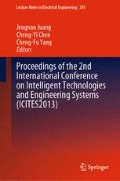Abstract
In this study, an Android smartphone was used to control a robot of Lego NXT running leJOS by automatically tracking and pushing a ball forward. OpenCV was run on the smartphone for ball recognition. In addition, HCT (Hough Circle Transform) was used to recognize circular objects of particular colors in the environment. Furthermore, the smartphone controlled the robot with Bluetooth wireless communication.
Access this chapter
Tax calculation will be finalised at checkout
Purchases are for personal use only
References
Wong, W. K., Jai, Y. S., & Wei, J. C. (2011). Robotic applications with FPGA implementation of java virtual machine. International Journal of Intelligent Technologies and Engineering Systems, 1(1), 32–38.
Uichin, L., et al. (2010). P2P content distribution to mobile Bluetooth users. IEEE Transactions on Vehicular Technology, 59, 356–367.
Hough, P. V. C. (1962). Method and means for recognizing complex patterns. US Patent 3,069,654.
Duda, R. O., & Hart R. E. (1972). Use of the Hough transform to detect lines and curves in pictures. CACM, 15(1), 11–15.
Carlson C. F. (2005). Lecture 10: Hough circle transform. Rochester Institute of Technology: Lecture Notes, October 11, 2005.
Author information
Authors and Affiliations
Corresponding author
Editor information
Editors and Affiliations
Rights and permissions
Copyright information
© 2014 Springer International Publishing Switzerland
About this paper
Cite this paper
Chao, TK., Yang, BS., Wong, WK., Yin, SK. (2014). Using an Android Smartphone for Robotic Image Recognition. In: Juang, J., Chen, CY., Yang, CF. (eds) Proceedings of the 2nd International Conference on Intelligent Technologies and Engineering Systems (ICITES2013). Lecture Notes in Electrical Engineering, vol 293. Springer, Cham. https://doi.org/10.1007/978-3-319-04573-3_5
Download citation
DOI: https://doi.org/10.1007/978-3-319-04573-3_5
Publisher Name: Springer, Cham
Print ISBN: 978-3-319-04572-6
Online ISBN: 978-3-319-04573-3
eBook Packages: EngineeringEngineering (R0)

